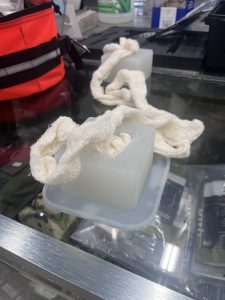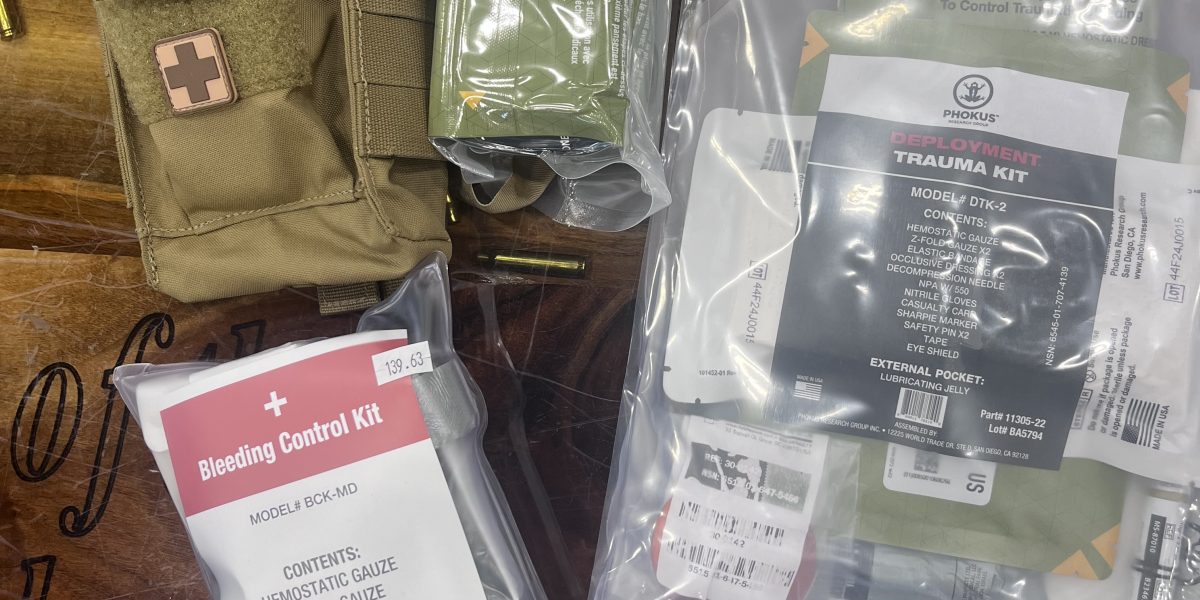As a former Army Medic and EMT, nothing gets my jollies off more than a well equipped IFAK, and when people take our Bleeding Management Techniques (BMT) class. Just in 2025 alone, we have had two separate students express their gratitude for this training, as they have had to use it in real world situations while at work. Sedgwick County EMS averages around 60,000 Emergency calls a year, and it goes up as our population increases. Meanwhile the average response time is a little over 7 minutes. A lot can happen in 7 minutes, so doing your part in being prepared and knowing what to do is crucial for you, and your friends and families survival.
As a gun range and firearm retailer, a lot of focus is put on the “Tactical Environment”, however the vast majority of us do not don kit and walk around Dillons. So the tactical environment is not something we find ourselves in. However, accidents at home and work happen daily around the city. Car crashes and natural disasters such as tornados, are a part of our lives and we do not get to choose when and where they strike. Our BMT class does not solely focus on gunfighting, but everyday life.
Without giving away all of our secret sauce, I will give a quick synopsis on what we go through.
- Who the first responder is.
In many cases, it will be you. Having first and foremost, the knowledge, is absolutely vital for patient outcomes. Then of course, equipment.
- Types of bleeding.
Not every bleed will need a Torniquet, and being able to tell the difference can save you and the patient some discomfort and stress. (We will also discuss some of the common myths as it comes to Tourniquet usage.)
- Airway.
Is it open and patent? Do we know what that means? Stopping a bleed is important, but if someone has “passed out”, do you know what to do to ensure an open airway?
- Hypothermia.
Regulation of body heat is diminished as we lose our blood volume. And on top of that, below an internal body temperature of about 93 degrees, clots do not form properly, if at all.
Inner city hospitals and the US Military work hand in hand to develop new strategies and research on how various forms of trauma affect the human body and its functions. At one point in time, tourniquets were seen as a last ditch effort to control bleeding. However, it has been found that wasting time leads to higher mortality rates and more work in the hospital setting. Including the reversal of hemorrhagic shock. Keep that blood in.

I have begun making our own wound cubes to practice wound packing techniques, and in later classes will incorporate artificial blood to stress the students out just a little bit more. Our warehouse has a 3D printer and we made a mold for silicone to be poured in and allowed to cure. I also recruited help from Mokas Raifus; an AK and combloc importer and builder who also has a 3D printer who churned out a few molds for me as well. I would like to thank an instagram user who goes by @nlifak for hooking me up with the print files to accomplish this task. Another big shoutout to @rimaua09 for connecting us and her work in Ukraine as a medic and TCCC instructor. She has been showing some of the success, and the failures as this conflict is giving us new data points on casualty care in a “peer to peer” combat. I will link her “buy me coffee” link below if you are interested in helping their cause over there. It also gives you access to her mailing list where she shares this knowledge.
As I am writing this, Kentucky got hit by a pretty bad tornado and we are seeing some touch down here in Kansas. In Kentucky, 19 are confirmed deceased and a dozen injured. Keep them in your thoughts and prayers, and do what you can to be an asset for your community. Having extra wool and mylar blankets may make the difference in preventing people from succumbing to exposure based injuries. Government agencies are not well known for their ability to provide timely aid for those affected by, well, anything. Urban explorers in areas affected by Katrina are still finding FEMA aid supplies just wasting away in places they had set up shop. Aside from medical supplies, even simple necessities such as food and water should be maintained in the home. Not necessarily doomsday prepper levels of readiness, but a few days. A few cases of water, canned food and trashbags. If water and sewer is cut off, proper disposal of waste is crucial for not only the prevention of illnesses, but peace of mind. You can’t eat a bullet (you know what I mean) or prevent hypothermia with a sweet AR. Being a prepared citizen is not just guns and plate carriers. Its having the knowledge and resources to tackle anything life throws at your community.
Pursue Your Passion. Through Training, Equipment, and Mindset
For the time being, we are going to offer half off of our bleeding management class with any purchase of an IFAK. If you already have a solid one, why not two? Jokes aside, sign up below or in store for the IFAK promo.
Bleeding Management Techniques
https://www.rainierarmsfa.com/classes/bleeding-control/
Rima’s Links
https://buymeacoffee.com/rimaziuraitis
https://www.instagram.com/rimaua09/?igsh=MWwwbDEydHV4MTVuNA%3D%3D#
NLIFAKS page
https://www.instagram.com/nlifak/?igsh=MXMybmk0eGgxNTlxYw%3D%3D#
Rainier Arms Firearms Training home: RAFA
RAFA: Visit us or drop us a line.
Take a look at the RAFA calendar of training.
Enroll in a RAFA shooting class.
Follow RAFA on Instagram: @rainierarmsfirearmsacademy.
Connect on Facebook: /rainierarmsfirearmsacademy/
Find RAFA on Twitter: @rainieracademy
Subscribe to the RAFA channel on YouTube: Rainier Media Haus



